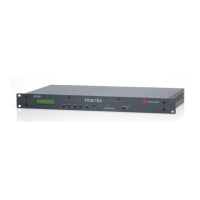DEFINITION OF TERMS
© Polycom, Inc. 37 VORTEX EF2201 Reference Manual
Equalization Equalization is the process of adjusting frequency characteristics of an audio signal.
Line Echo Line echo is caused by reflections of the audio signal from the telephone hybrid. The
EF2201 is an example of a device that includes a line echo canceller.
Macros An arbitrary set of commands that can be replayed.
Matrix Mixer A matrix mixer allows you to choose which inputs are included in each output. Some
matrix mixers allow you to assign crosspoint gains to the inputs.
Noise Cancellation Noise cancellation is a digital signal process that removes noise from an audio signal
corrupted by real-world interferences such as HVAC, office noise, crowd noise, or
road noise. Generally, there are two parts of a noise cancellation algorithm: a method
to detect the noise and a method to remove the noise. The Polycom noise cancellation
algorithm (patent pending) is capable of removing 10 dB or higher of noise with no
degradation at all to the resulting speech signal. This method does not attenuate
speech, and removes noise during both speech and idle periods.
NOM NOM refers to the number of open microphones in a system.
NOM Attenuation NOM attenuation is the gain applied to the overall system gain to the microphone sig-
nals to compensate for how many microphones are open. The amount of attenuation
is calculated by 10*log
10
(NOM).
NOM Bus A NOM bus carries signal information as well as NOM information (i.e., the number
of open microphones in the system, NOM).
Presets Presets correspond to configuration parameters that have been previously saved to
EEPROM.
Room Gain The room gain of a conferencing system refers to the relative levels of the signal sent
to the line output to your amplifier (before any amplification) and the level of this sig-
nal that is reflected at the microphone input (after microphone amplification). If the
electrical level of the reflected signal picked up by the microphone is the same as the
level of the electrical signal sent from the AEC to the line output to your amplifier,
the room gain of this microphone channel is said to be 0 dB. If the reflected signal
picked up by the microphone is higher than the level of the signal sent to the line out-
put to your amplifier, that microphone channel has positive room gain. The more
positive the room gain, the harder the AEC must work to determine which signal is an
echo and which is a local speech signal.

